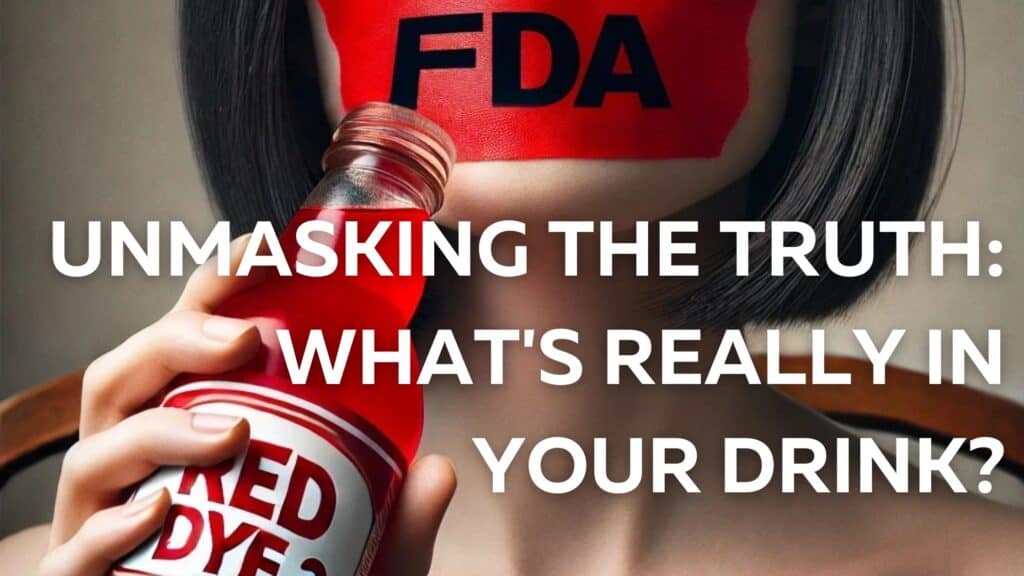The Red Dye No. 3 Ban: What Food Creators Need to Know and Why Behavioral Science Matters

The Onset Warning
The FDA, Food and Drugs Administration’s decision to ban Red Dye No. 3 (erythrosine)🚨 in food and ingested drugs has sent ripples through the food industry. This ban, announced in October 2023 (AP News), gave manufacturers deadlines to reformulate their products: January 2027 for food products and January 2028 for drugs (NY Post). The Red Dye 3 ban impact is expected to be significant.
Yet, over a year later, many consumers are just beginning to grapple with the implications as it’s being blasted on media. As food creators, understanding the nuances of this ban is essential, not just for compliance but for maintaining trust with consumers in an ever-evolving market.
The Impact on Small Companies
Small companies often face unique challenges in adapting to regulatory changes like this ban. Reformulating a product to remove Red Dye No. 3 isn’t as simple as swapping out one ingredient.
👀 Here’s what this process might look like:
- Ingredient Research: Identifying suitable replacements, such as natural colorants like beet juice, carmine, or anthocyanins from red cabbage.
- During my time in the Specialty Food Association Maker Prep Course, I learned about this process, where I explored the steps required to bring a product to market and get it picked up by stores. Ingredient formulas are critical since they directly impact what consumers will ingest and expect to remain consistent.
- This is why focus groups and testing are crucial—to ensure the formula is perfected with high-quality ingredients.
- ⚠️ Consistency is vital, as changes to the formula later on can lead to consumer resistance or the search for alternatives.
- Testing and Reformulation: Ensuring the alternative doesn’t alter the product’s taste, texture, or shelf life.
- Compliance Checks: Working with regulatory consultants to ensure the new formula meets FDA and state-level requirements.
- Supply Chain Adjustments: Sourcing new ingredients, which may be costlier or have different availability constraints.
For small companies, these steps can lead to significant costs, logistical hurdles, and potential delays. Without proper planning, some may risk fines or even closure.
Why Wasn’t Red Dye No. 40 Banned Too?
The FDA’s decision to ban Red Dye No. 3 has led to questions about why other synthetic dyes, particularly Red Dye No. 40, remain approved. Red Dye No. 3 was banned due to strong evidence linking it to cancer in animal studies (AP News). In contrast, Red Dye No. 40, while also scrutinized, lacks the same level of definitive evidence (CBS News).
Red Dye No. 40, or Allura Red AC, has been associated with potential behavioral effects in children, such as hyperactivity and other minor health concerns. During my time working as an ABA registered behavioral technician, I heard many parents express concerns about Red Dye No. 40 and share how removing it from their children’s diets seemed to improve behavior.
What Should the FDA Do?
However, as a data-driven person, I researched the topic myself and found that while there are anecdotal claims, the scientific evidence does not definitively support these effects. The FDA has not revisited the safety of Red Dye No. 40 in over a decade (CBS News), and current evidence does not meet the threshold for a ban.
The difference lies in the conclusive animal studies for Red Dye No. 3 versus the less definitive research surrounding Red Dye No. 40.
What Should Food Creators Do?
For food creators, this disparity highlights the need to stay informed about potential regulatory changes, as consumer advocacy and ongoing research could eventually influence the status of Red Dye No. 40 and possibly fund more research associated with it.
Behavioral Science Insights
Studying past regulatory changes shows us that human behavior often follows predictable patterns. When people are denied something they’ve grown accustomed to, they respond in one of two ways:
- Resistance: Protests or backlash against the change. For example, some consumers might lament the loss of certain candies or foods they associate with nostalgia.
- Adaptation: Seeking alternatives that provide similar effects, ditching their loyalty to a brand. This often happens when companies introduce reformulated products or new offerings that fill the void left by banned ingredients.
For companies, this means one thing: replacements are inevitable. Businesses that proactively reformulate their products and communicate the changes transparently are more likely to retain consumer trust. But just be ready for the consequences if they don’t.
Proactive vs. Reactive Approaches
A key question arises: will companies wait for bans to affect them directly, or will they take a proactive approach?
- Proactive Companies: These businesses anticipate future bans and begin reformulating early. This builds consumer trust and positions them as industry leaders. For example, companies that phased out artificial trans fats ahead of the FDA’s ban benefited from goodwill and brand loyalty.
- Reactive Companies: Waiting until the last minute often leads to rushed decisions, higher costs, and potential product recalls. This approach can damage brand reputation and erode consumer confidence.
The risks are clear. Staying ahead of the curve ensures not only compliance but also brand resilience in the face of regulatory shifts.
Frequently Asked Questions
- What is Red Dye No. 3, and why was it banned? Red Dye No. 3 is a synthetic colorant linked to cancer in animal studies. The FDA’s decision aligns with the Delaney Clause, which prohibits additives found to cause cancer in humans or animals.
- When were manufacturers informed about the ban? The FDA announced the ban in October 2023, giving manufacturers over three years to comply for food products and nearly five years for ingested drugs.
- What products are affected? Candies, baked goods, snacks, beverages, and some medications containing Red Dye No. 3 are all impacted.
- What are the alternatives to Red Dye No. 3? Alternatives include natural colorants like beet juice, carmine, and pigments from red cabbage or purple sweet potato.
- Why hasn’t Red Dye No. 40 been banned? While Red Dye No. 40 has raised concerns about potential behavioral effects in children, it lacks the definitive evidence required for a ban, unlike Red Dye No. 3, which has clear links to cancer in animal studies.
Your Role & Its Impact
By adapting to the following changes, food content influencers can maintain their audience’s trust and contribute to a more informed, health-conscious consumer base. It is also important for influencers to remember that saying yes to every company seeking promotion can negatively affect their brand.
The Role of Food Creators
As food creators, we’re not just making products—we’re shaping consumer habits and trust. Understanding and adapting to regulatory changes like the Red Dye No. 3 ban is crucial. By prioritizing high-quality ingredients and ethical practices, we stay compliant and build stronger connections with our audience.
For example, one of Growth Culinary’s 8 Core Values is Integrity: “We conduct our business with honesty, transparency, and professionalism, building trust and long-lasting relationships with our clients and partners.” If not, things will eventually fall apart in a costly way.
The Impact on Food Content Influencers
The Red Dye No. 3 ban also significantly affects food content influencers who showcase recipes, review products, and educate their audiences. Many influencers may unknowingly promote products that contain banned or controversial ingredients, which can damage their credibility as advocates for quality and health-conscious choices.
To navigate these changes:
- Stay Informed: Influencers must keep up with regulatory changes and ingredient updates to ensure the products they promote align with current standards.
- Communicate Transparently: Sharing knowledge about ingredient bans and reformulations with audiences can build trust and position influencers as reliable sources of information.
- Partner Strategically: Choose collaborations with brands that demonstrate ethical practices and proactive adaptation to regulatory changes. Highlighting these partnerships can enhance an influencer’s reputation.
- Adapt Content: Update recipes, reviews, and recommendations to align with new regulations, ensuring followers receive up-to-date and accurate guidance.
Remember! You are a consumer as well, and building trust means only promoting products that you would genuinely use yourself. This authenticity reinforces credibility and strengthens the bond with your audience, ensuring they see you as a reliable advocate for quality and ethical practices.
Lessons from Behavioral Science
Behavioral science teaches us that consumer habits evolve. When companies take shortcuts or fail to adapt to regulatory changes, they risk losing the trust of their customers. On the other hand, those who invest in quality and transparency often become the brands consumers turn to during times of uncertainty.
Further Reading
- US bans popular red dye from foods – 35 years after it was banned in cosmetics
- FDA Bans Artificial Dye Red 3 From Food
- FDA bans red dye No. 3 from foods
- What is Red Dye No. 40 and its effects?
My Final Two Cents
The Red Dye No. 3 ban is a reminder of the importance of staying informed and proactive. For food creators, it’s an opportunity to lead by example, demonstrating our commitment to health, safety, and innovation. Let’s use this moment to build trust with our consumers and set a new standard for the food industry. Who’s banned next? TikTok, man, do I have a lot to say about this! In the meantime, catch up on my other post: Emoji Spam Bots are Invading TikTok!
Suggested Reads
- Meet Chef Maika: Your Guide to Flavorful Recipes, Blogging
- Growth Culinary’s 8 Core Values: A Recipe for Success
- Growth Culinary: Empowering Culinary Creators
- Emoji Spam Bots are Invading TikTok!
- A Comprehensive Guide to SEO for New Food Bloggers

Chef Maika Frederic
Owner, Growth CulinaryChef Maika, founder of Growth Culinary LLC, leverages her expertise as a culinary entrepreneur to power innovative brands like Just Maika Cooking and Custom Herb Spice Shop while sharing insights on culinary trends and entrepreneurial challenges. Read more about Chef Maika.


